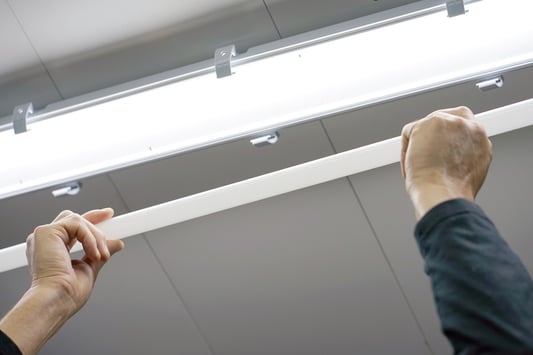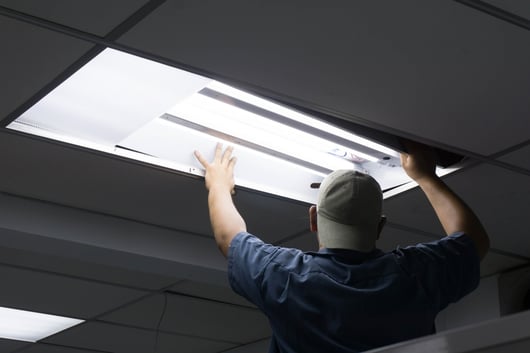Types of LED Lighting Upgrades: Lamp Replacements, Retrofits and Fixture Replacements

LED lighting upgrades can be classified into three broad types based on how much the existing installation is modified: lamp replacements, retrofits and fixture replacements. You can normally achieve higher performance by upgrading more lighting system components, but the project cost is also increased. However, governments and utility companies may introduce rebate programs for energy-efficient lighting, and an expensive project can end up having an attractive cost after a good rebate.
Like with any energy efficiency measure, a technical and financial analysis of the project is highly recommended before proceeding. This way, you can prioritize the specific upgrades that yield the highest return on investment. Although many factors determine project performance, the following tend to be the most relevant:
- Upgrading lighting systems with long operating schedules first is recommended. Keep in mind that energy savings are the product of power saved and hours of use. The most efficient LED bulb in the market will not save much energy if the fixture where you install it is rarely used.
- Lighting upgrades inside air-conditioned and refrigerated spaces provide two types of savings: a direct reduction in lighting power, and also a reduction of the amount of heat handled by cooling equipment.
- The project achieves better results when the technology gap between the proposed and the existing lighting system is broader. For example, upgrading from incandescent to LED lighting yields more savings that upgrading from fluorescent, even if the final project consumes the same power in both cases.
This article will provide a brief overview of the main types of lighting upgrades, along with general recommendations for each case.
Lamp Replacements
The simplest type of lighting upgrade is replacing existing bulbs with equivalent versions having better performance. This type of lighting upgrade can be performed quickly and for a relatively low cost, making it an attractive option for companies who want to minimize disruption or who have a limited budget for energy efficiency projects. The main aspects to consider before proceeding with a lamp replacement are the following:
| FIXTURE / LAMP PROPERTY | IMPORTANCE |
| Lamp Base Compatibility |
The proposed replacement lamps must be compatible with the sockets in the existing fixtures. Most bases use either an edison screw or multiple pins, and LED upgrades are available in each case.
|
| Ballast Compatibility | Many replacement lamps are designed for the same ballasts used by the previous lamps, making the upgrade extremely simple. However, replacement lamps may also be designed for direct connection to the power supply, and if this is the case you must rewire the fixture and bypass the ballast. Some upgrade lamps are universal, compatible with both a ballast and a direct connection. |
| Light Beam Shape | Do not assume that two lamps having the same base shape can be used in place of each other, since the beam shape varies dramatically according to the application. For example, you can find both globe bulbs and parabolic bulbs with medium bases (E26), but the globe bulb projects light in every direction while the parabolic bulb concentrates it in a narrow beam. |
Replacement lamps must also be selected with suitable lighting properties, depending on each application. They should deliver sufficient illuminance (lumens per square meter), while having the right color temperature (CCT) and the highest possible color rendering index (CRI) that meets the project budget.
- Low CCT values (warm colors) work better when you want to create a relaxing environment, while high CCT values (cool colors) are recommended when visibility and awareness are important - in sports venues and manufacturing applications, for example.
- On the other hand, the CRI is not specific for each application; a higher color rendition is always better but generally costs more.
Lighting designers use software such as DIALux to simulate the specified luminaires and fixtures, ensuring they deliver adequate lighting for their intended application.

If you are looking for replacement lamps, make sure you purchase products with the blue ENERGY STAR logo, which ensures high performance and intensive laboratory testing. In commercial and industrial applications you may find the DLC label instead (Design Lights Consortium). Both programs have very strict labeling requirements, so their respective logos indicate high quality and performance. They are mutually exclusive for most product categories, so don’t look for replacement lamps with both labels.
Retrofits
A retrofit is one step above a lamp replacement in complexity: existing lighting fixtures are reused, but with significant changes to their internal configuration.
- An example of a retrofit would be taking a strip fixture with two 8-foot T12 fluorescent tubes and modifying it to use two parallel sets of 4-foot LED tubes.
- This process involves bypassing or removing the ballast, changing the lamp bases, and adding additional bases halfway through the fixture body.
- If the LED tubes specified use an external driver, it must be mounted inside the fixture as well. Drivers are similar to ballasts, but exclusive for LED and with additional lighting control features.
Some retrofits stick to a similar topology as the lamps replaced, like the example above where 8-foot fluorescent tubes are replaced with 4-foot LED tubes. However, some lighting providers change the configuration completely; for example, there are rectangular retrofit kits with light engines that do not resemble tubes at all, intended for existing 2x4 or 2x2 fixtures. Retrofits kits are also commonly used with decorative fixtures, to preserve the fixture body while improving lighting performance.

Basically, a retrofit is intermediate between a lamp replacement and a fixture replacement. The fixture is partially modified and the light source is changed completely, but the fixture body is preserved. Many internal components are replaced or rewired, but not necessarily all of them.
Fixture Replacements
With this type of lighting upgrade the existing fixtures are removed completely, including the housing. A complete fixture replacement is the most expensive lighting upgrade, but it also tends to deliver the highest energy savings: integral LED fixtures are designed with an internal geometry that maximizes lighting delivered to working planes. On the other hand, with relamps and retrofits you are subject to the optical performance of the existing fixture.
Rebate programs tend to offer higher incentives for full fixture replacements, compared with relamps and retrofits. Consider the following examples for LED lighting, from the Con Edison incentive program:
- You get an incentive of $90 for replacing a 400W high-bay HID fixture, but only get $60 for a relamp or a retrofit.
- In the case of linear fluorescent troffers, an incentive of $10 to $30 applies depending on lamp dimensions (1x4, 2x2, 2x4) and existing number of tubes (1-4), but only if the upgrade is a retrofit kit or a new fixture.
- You get $75 if you replace a parking garage luminaire up to 100W with a new LED fixture, but only $50 for a relamp or a retrofit.
Keep in mind that these incentives apply as of March 2018, but Con Edison may decide to review them.
Conclusion
There are many options available if you plan to upgrade the lighting system in your building. In general, LED lighting is a cost-effective investment due to its superior energy efficiency and long service life, but LED products are characterized by diversity and too many options can cause confusion. Get a professional lighting assessment to find the most promising lighting upgrades, and also make sure you don’t miss any Con Edison incentives. The incentive per fixture may not seem much, but consider that a large NYC building can have thousands of fixtures.
If your property is covered by Local Law 88, having a lighting system that meets the NYC Energy Conservation Code is mandatory by 2025. Although there is still plenty of time, you can start saving electricity earlier by acting fast.

Michael Tobias
Michael Tobias, the Founding Principal of NY Engineers, currently leads a team of 150+ MEP/FP engineers and has led over 4,000 projects in the US
Join 15,000+ Fellow Architects and Contractors
Get expert engineering tips straight to your inbox. Subscribe to the NY Engineers Blog below.
